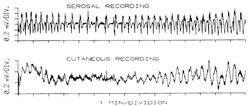

Inside Tract
November 28, 2014
Physicians have known about the electrical system in the gut since as far back as the 1920s. But until recently, there’d been no easy way to measure the electrical signals in our stomachs.
Without an invasive probe, says Jiande Chen, there was no way to distinguish the faint electrical impulses in the gastric system from heart sounds or breathing sounds.
Today, Chen says, the science of electrogastrography allows measurement of electrical impulses in patients’ stomachs using simple cutaneous electrodes.
Similar to the way that electrocardiography measures the heart’s electrical impulses, electrogastrography (EGG) tracks the waves in the stomach and can detect motility problems.
“Stomachs have pacemakers, just like hearts do,” says Chen. “Only the frequency in the stomach is much lower, at three waves per minute.”
Gentler than signals of post-meal peristalsis, the so-called slow waves pace the stomach. Variations from the three waves per minute indicate motility troubles.
“Again, just like if you have tachycardia, the impulses are too fast and the heart goes into fibrillation,” Chen says. “In the stomach, it’s the same. If the slow-wave beats go above four cycles per minute, then the stomach doesn’t contract and the patient has problems.”
“One of the first things I tried to do was to determine whether the recording we got on the surface of the patient’s skin was measuring the same event that a catheter deep in the patient’s stomach was measuring,” Chen says.
As they compared data from the two sources, Chen and his colleagues concluded that the EGG recordings were, indeed, measuring the same slow waves as the catheters deep inside the patients.
Chen and his team did another important study to prove that EGG measures the right electrical activity.
“We know that in newborns, the stomach is not mature,” Chen explains. “They don’t eat solid food for the first few months of their lives. We tested them with EGG, beginning right at birth, then at 2 months old, then at 6 months old. We found increasing electrowaves as their ages increased. And we concluded that function of the stomach matures gradually.”
Chen also did an EGG study comparing 2-year-olds with adults. “They’re the same,” he says of the electric waves. “No difference. At only 2 years old, the stomach has the same three-per-minute waves that adults have.”
Abnormal slow-wave activity can indicate digestive disorders ranging from functional dyspepsia to gastroparesis. As more doctors learn of Chen’s discoveries, the test is growing in popularity. At Johns Hopkins, EGG testing has become part of the diagnostic arensal of the GI and motility practitioners.
Not Just Testing the Waves
Jiande Chen’s work with stomach electrowaves may lead to more than just diagnostic data. Chen is part of a group of doctors, researchers and engineers who are developing a wearable electrostimulator that uses the same theories as acupuncture.
“We’re working on something that looks like a wristwatch but delivers a faint electrical stimulation to the acupuncture point that is associated with these stomach waves,” he says. “Our early clinical trials have been very positive and very exciting.”

